Difference Between a Sauna and Steam Room: Which Is Right for You?
Looking to enhance your home wellness routine? Saunas and steam rooms are both fantastic for your body and mind—but they’re not the same. From how they feel to how they function, choosing between the two comes down to your preferences, space, and health goals.
health goals. Let’s break down the difference between a sauna and steam room—quickly, clearly, and with expert guidance.
Quick Comparison: Sauna vs. Steam Room at a Glance


SAUNAS
STEAM ROOMS
-
Saunas use dry heat.
-
Steam rooms use moist heat.
-
Saunas run hotter (160–220°F).
-
Steam rooms are cooler (110–120°F).
-
Saunas have low humidity (5–30%).
-
Steam rooms offer 100% humidity.
-
Saunas are freestanding units.
-
Steam rooms are freestanding or can integrate with your shower.
-
Saunas are better for muscle recovery and circulation.
-
Steam rooms excel at skin hydration and respiratory relief.
Understanding the Basics
What Is a Sauna?
In this section, include an image of a sauna with a button beneath that says EXPLORE SAUNAS.
A sauna is designed to provide dry heat sessions, typically heated between 160°F and 220°F. The low-humidity environment promotes sweating, aiding detoxification and muscle relaxation. Traditional saunas use wood-burning stoves or electric heaters to warm the air and stones, which can be sprinkled with water for a brief humidity boost.
What Is a Steam Room?
In this section, include an image of a sauna with a button beneath that says EXPLORE STEAM ROOMS.
A steam room, or steam shower, generates moist heat by boiling water to produce steam, maintaining a temperature around 110°F to 120°F with 100% humidity. This environment opens pores, hydrates the skin, and can alleviate respiratory issues.
The Breakdown: The Difference Between a Sauna and Steam Room
While people often use the terms interchangeably, there’s a clear difference between a sauna and steam room.
Feature
Sauna
Steam Room
🔥Heat Type
Dry (via electric, wood, or infrared)
Moist (via steam generator)
🌡️Temperature
160–220°F
110–120°F
💧Humidity
Low (5–30%)
Very High (100%)
🔍Material
Wood-lined interiors
Non-porous materials like tile
⚒️Installation
Freestanding, indoor/outdoor
Integrated into bathrooms or prefab steam showers
🧹Maintenance
Low (ventilation + basic cleaning)
High (moisture management, sealing, mold prevention)
💪 Health Focus
Detox, circulation, muscle relief
Skin hydration, congestion relief, relaxation
Health Benefits Backed by Research
Sauna Benefits
Recent research shows that regular sauna use can significantly enhance cardiovascular health, reduce chronic inflammation, and promote longevity.
-
Circulation & Heart Health: A 2015 Finnish study found that men who used a sauna 4–7 times per week had a 50% lower risk of fatal heart disease.
-
Muscle Recovery: Dry heat helps relax muscles and relieve joint pain, especially after exercise.
-
Detoxification: Sweating helps flush out toxins and heavy metals.
-
Stress & Sleep: According to multiple studies cited by Healthline, heat exposure increases endorphins and helps regulate cortisol, improving sleep and mental health.
Steam Room Benefits
Steam rooms excel at moisture therapy and respiratory health.
-
Skin Hydration: High humidity moisturizes the skin and opens pores, according to research shared by WebMD.
-
Respiratory Relief: Steam inhalation is known to help with asthma, sinus congestion, and colds.
-
Pain Relief: The heat and moisture soothe sore muscles and stiff joints.
-
Mental Wellness: Healthline reports that the calming environment promotes relaxation and reduces tension.
Which One is Best For You?
Choosing between a sauna and a steam room often comes down to your personal preferences, health needs, and space. Here’s a quick guide on who each option is best suited for:
A Sauna Is Best For You If...
-
You prefer dry heat over a humid environment.
-
You're focused on muscle recovery, cardiovascular health, or detoxification.
-
You want a lower-maintenance setup with fewer moisture-related concerns.
-
You have outdoor space or a dedicated indoor area and love the traditional sauna experience.
-
You’re sensitive to high humidity but still want to enjoy the health benefits of heat exposure.
A Steam Room Is Best For You If...
-
You need relief from respiratory issues like asthma, allergies, or congestion.
-
You have dry or problematic skin and want to hydrate and open pores.
-
You prefer a moist, spa-like heat that feels more like a tropical escape.
-
You’re looking for an all-in-one bathroom upgrade, especially with a steam shower or tub combo.
-
You enjoy shorter sessions and want an immersive, high-humidity environment to unwind in.
Top Product Picks: Sauna & Steam Room Options
Let’s explore the best of both worlds—one incredible sauna and two luxury steam rooms you can bring home today.
One of our bestselling indoor saunas, the Rainelle combines timeless craftsmanship with modern functionality. It features tongue-and-groove lumber, tempered glass doors, stainless steel hardware, and an interior LED light for a warm, peaceful glow. Powered by a best-in-class electric heater and sauna stones, it also offers a hybrid upgrade with both electric and infrared heating.
✅ Seats 3–4 people
✅ Premium materials (1-3/8” lumber, stainless steel, tempered glass)
✅ Optional hybrid heat (infrared + electric)
✅ Great for detox, relaxation, and improved circulation
Explore more in our Sauna Collection.
This luxury steam shower tub combo blends form, function, and flair. Featuring 10 acupuncture body jets, a rainfall shower head, and a 3KW steam generator, the WS-608P offers a complete spa experience in one sleek unit. Control everything with the digital LCD panel—temperature, lighting, audio, and even the built-in FM radio.
✅ Steam + hydrotherapy + jetted tub
✅ Blue glass panels, LED mood lighting, and Bluetooth audio
✅ Foot massager, towel rack, dual shower wands
✅ Easy integration into most bathroom spaces
Discover more in our Mesa Steam Showers Collection.
The Arezzo Platinum delivers next-level luxury with a 5KW steam generator, 16 acupuncture massage jets, aromatherapy, and even a 12" smart TV. Yes, really. Add in fluorescent lighting, ozone sterilization, and a rainfall ceiling shower, and you’ve got a full-on sanctuary for rest, detox, and indulgence.
✅ High-end steam performance + built-in entertainment
✅ Surround sound system with Bluetooth, FM, and TV
✅ Ozone system for a sanitary experience
✅ Hands-free phone and waterproof remote control
Browse our Maya Bath Steam Showers Collection.
Installation Considerations
Sauna Installation
Saunas require a dedicated space, proper ventilation, and an electrical setup. They can be installed indoors or outdoors, depending on your preference.
Steam Room Installation
Steam rooms can be integrated into existing bathrooms or showers using a steam generator. To prevent moisture damage, the area must be sealed and constructed with non-porous materials.
Maintenance and Upkeep
Sauna Maintenance
-
Cleaning: Regularly wipe down surfaces to remove sweat and bacteria.
-
Ventilation: Ensure proper airflow to prevent mold and mildew.
-
Wood Care: Treat wood surfaces periodically to maintain quality.
Steam Room Maintenance
-
Cleaning: Due to high humidity, steam rooms require frequent cleaning to prevent mold and bacteria growth.
-
Seal Integrity: Regularly check seals and grout to prevent leaks.
-
Ventilation: Ensure adequate ventilation to manage moisture levels.
FAQs About Saunas and Steam Rooms
Saunas are generally better for muscle recovery due to their dry heat, which helps relax muscles and alleviate soreness.
Yes, compact models are available for both saunas and steam rooms that can fit into smaller spaces.
Limiting sessions to 15-20 minutes is recommended to avoid dehydration and overheating.
Individuals with certain health conditions should consult a healthcare provider before use.
Final Thoughts
Both saunas and steam rooms offer unique health benefits and relaxation experiences. Your choice depends on personal preferences, health goals, and space considerations. Explore our Sauna Collection and Indoor Spa & Steam Room Collection to find the perfect fit for your home wellness journey.
SIGN UP. SAVE BIG.
Subscribe to be the first to know about our special monthly sauna sales, sent right to your inbox.

About the Author
Adam Fromson
Adam Fromson, co-founder of My Sauna World, loves saunas and their transformative health benefits. With years of experience exploring sauna culture and its impact on health and wellness, Adam is passionate about helping others discover the life-changing benefits of saunas for themselves.
Let customers speak for us
from 385 reviews
Good communication, easy delivery, easy set up, easy operation, great value. Recommended!
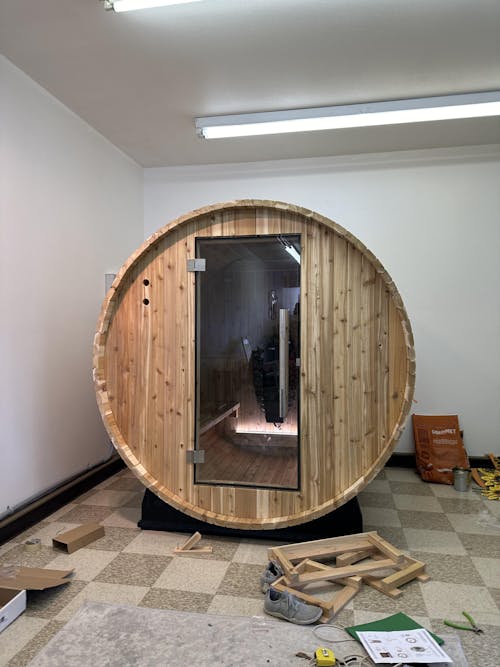
We ordered the 4 person barrel sauna and love it! We wanted a little extra space for the 2 of us/guests and it’s great. We could definitely fit 4 people in it if we needed. We use it every single day. It took about 10 weeks to get here because they build it specifically for the order. Putting the barrel together was fairly easy with 2 people. The electrical and the heater definitely required an electrician to install as we could have not done it alone.
We ordered the biggest heater (harvia spirit 8kw) and it heats up the sauna in about 15 mins inside our 40-50° garage. Overall this style of sauna is hotter and you sweat a lot faster than in an infrared sauna. I truly 10/10 recommend!
Pic is of us in the middle of building it.
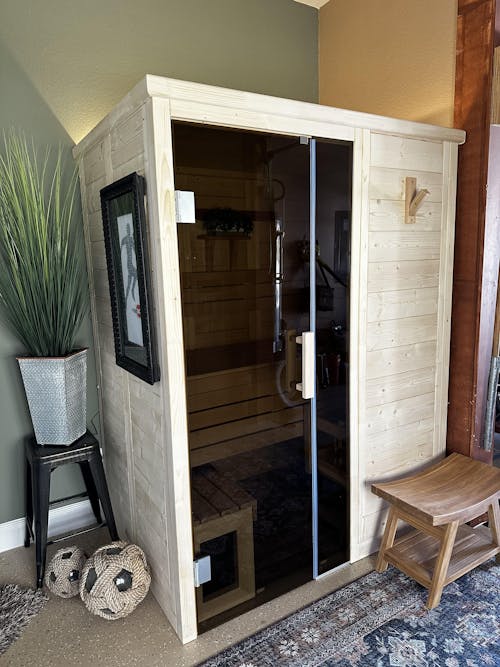
Took me about 6 hours over 2 evenings to assemble almost all by myself. Had a pro run a new circuit from my panel. Very well made and assembly was straightforward. Heater is well sized and reaches operating temperature in under 30 minutes.

Great sauna very easy to assemble

The salt panel was a great addition to our Madison Sauna. It has excellent grain which is accented by the amazing color lights that glow through the panel. Also when you hit the rocks with a splash of water you can feel the heat bounce off the panel. Great addition if you are considering this option.
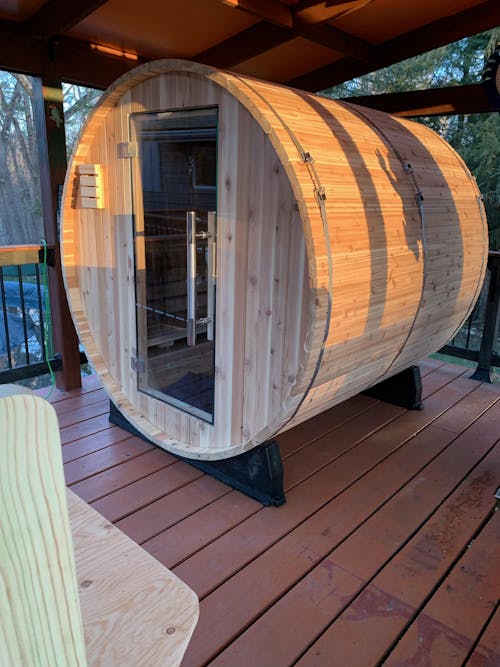
We can say enough about Sauna World there customer support is great! Our Pinnacle Sauna from Almost Heaven is epic.
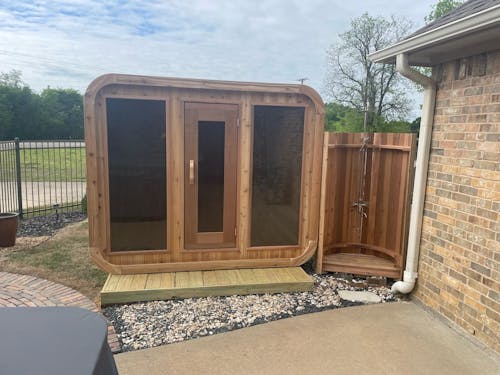
The finish and quality is outstanding and it was quick and easy to assemble.
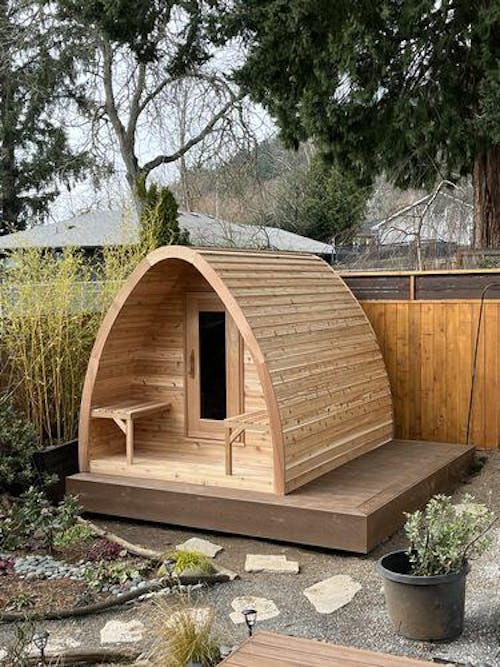
We are thrilled with our mini pod!! It came well shipped and our friend assembled it in 11 hours! Wow! We cannot wait to get healthy and sauna it up!

Beautiful sauna!!! Much easier than I expected to assemble, took a total of 4 hours. Can't wait to get warm by the pool on those cool evenings. Customer service was excellent..

Purchased a 2 person Almost Heaven barrel sauna and were delighted with the product. The order process was quick and easy, the sauna arrived on-time, installation was simple, following the provided instructions, and the sauna is extremely high quality. We’ve used it daily for over 2 weeks and quite frankly I don’t know how we lived without it. If I had it to do over again I wouldn’t change a thing... except maybe purchasing a 4 person model to easier share with friends!
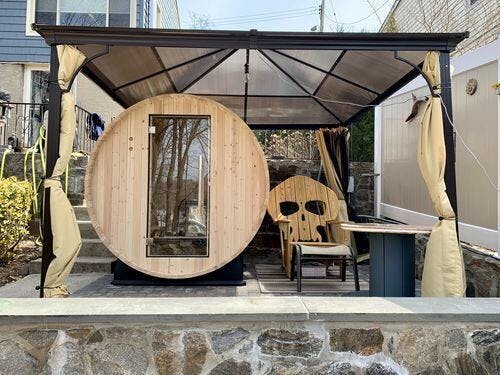
Great Customer Service and a breeze to put together.Excellent shipping and the Sauna is top notch, couldn’t be happier






























